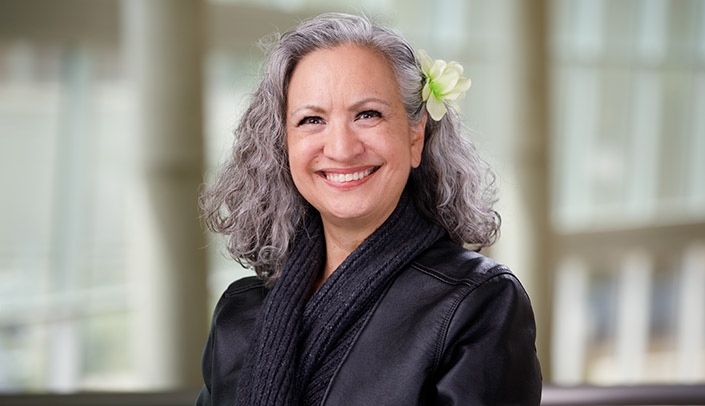It’s not clear when to use African American or Black; Latino, Hispanic or Latinx; American Indian, Alaska Native, Native American or indigenous. The term Asian American refers to a vastly heterogeneous group and is even more vague.
For Alaskan Native Siobhan Wescott, MD, such questions sparked a PubMed search for the most relevant terms for Native Americans and a scholarly project that could yield reporting changes on a national scale.
On Oct. 29, Dr. Wescott, director of American Indian Health in the UNMC College of Public Health and inaugural holder of the Dr. Susan and Susette (Inshata Theumba) LaFlesche Professorship in Public Health, kicked off UNMC’s fall Breakthrough Thinking series with "Filling the Void of What Terms to Use for a Population: Native Americans as an Example."
"Ideally you’d use terms preferred by the population," she said, noting the project will distinguish American Indians and Alaska Natives as two distinct groups and provide recommendations on how to pick and use the appropriate term.
View a recording of the session.
The project also looks at how data is reported and how to change reporting guidelines nationally so individuals with multiracial backgrounds can identify as such, rather than choose only one race from an established set of races.
Race is a social construct, she said, and knowing the granularity of race matters in health care and when developing culturally relevant programming.
Attendees also heard from Jane Jih, MD, on the "Absence of Evidence Is Not Evidence of Absence: Asian American Health and Anti-Asian Racism." Dr. Jih is an internist and investigator in the division of general internal medicine at the University of California San Francisco, where she is associate professor of medicine.
Asian Americans trace their heritage to more than 30 different countries and ethnic groups and speak over 100 languages and dialects, Dr. Jih said. "It’s a very heterogenous group, each with different immigration patterns, social economic status, dietary and cultural practice and different languages, which raise all sorts of challenges for data and access for health."
Asian Americans are the fastest growing racial group in the country, she said, yet, more than 40 percent of Americans cannot name a single prominent Asian American.
In studying Asian American health, she said, it’s critical to look at specific groups: "Looking at Asians together masks disparities until you look at specific groups. The absence of evidence is not evidence of absence."
Access and quality of care are limited, she said, with inconsistent use of interpreters; limited National Institutes of Health-funded research projects with Asian Americans, Native Hawaiian and Pacific Islander participants; and stereotyping all Asian Americans as high achieving, rule abiding and high earning.
To address disparities, Dr. Jih suggests:
- Improving data collection (in language) and quality (disaggregation);
- Allocating resources not solely based on presence of health disparities;
- Enforcing language access requirements;
- Supporting organizations with expertise in Asian American communities;
- Building and sustaining cross-racial alliances and allyship; and
- Implementing multilevel public education campaigns.
